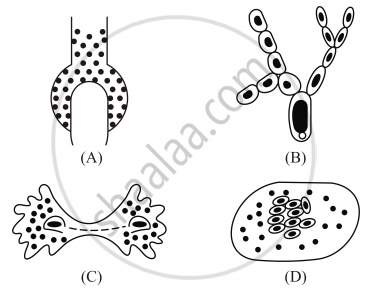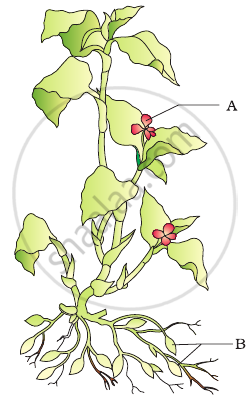Advertisements
Advertisements
प्रश्न
Identify the type of reproduction from the following explanation and draw a neat and labelled diagram.
- The body of the parent organism breaks up into many fragments and each fragment starts to live as an independent new organism.
- Give two examples of living organisms which follow this type of reproduction method.
उत्तर
- Fragmentation is the process of asexual reproduction in which the parent body breaks into many pieces or fragments and the fragments develop into mature filaments.
- Spirogyra and Sycon reproduce through the process of fragmentation.

APPEARS IN
संबंधित प्रश्न
External fertilisation takes place in frogs.
Fill in the following blank with suitable word :
Strawberry plants are propagated by the natural............... method.
How does binary fission differ from multiple fission?
Why does bread mould grow profusely on a moist slice of bread but not on a dry slice of bread?
What is meant by multiple fission? Name one organism which reproduces by the process of multiple fission.
What is yeast? Describe the process of reproduction in yeast with the help of labelled diagrams.
Name a tiny fresh-water animal which reproduces by the same method as that of yeast? What is this method known as?
Name two fruit trees which are usually propagated by grafting method.
In Spirogyra, asexual reproduction takes place by :
(a) division of a cell into two cells
(b) breaking up of filaments into smaller bits
(c) division of a cell into many cells
(d) formation of a large number of buds
An organism having a whip-like structure at one end which reproduces by the process of binary fission is :
(a) Hydra
(b) Paramecium
(c) Leishmania
(d) Plasmodium
A thickened underground stem X of a plant which is swollen with stored food has a number of points Y on its surface. When the old stem X is planted in the soil of a field in the next growing season, then each point Y present on its surface grows into a new plant.
(a) What is the general name of the underground stems like X?
(b) Give one example of X.
(c) What are points Y present on X known as?
(d) Is it necessary to plant the whole of stem X in the ground to obtain its new plants? Explain your answer.
(e) What is the name of this method of reproduction of plants?
(f) What is the advantage of growing new plants from the underground stems like X?
Why is it disadvantageous to grow plants vegetatively?
Multiple choice question. Tick (✓) the correct choice:
The common method of reproduction in bacteria is
- budding
- fragmentation
- binary fission
- all the above
Multiple choice question. Tick (✓) the correct choice:
Reproduction or propagation by stem is common in
- begonia
- potato
- sweet potato
- Bryophyllum
Fill in the blank:
Budding is a kind of _________ reproduction.
Fill in the blank:
The amount of cytoplasm in the parent cell is _____ than the amount in the bud.
State whether the following statement is true (T) or false (F):
A potato tuber is really an underground stem.
State whether the following statement is true (T) or false (F):
A whole new plant can grow from the eye of a tuber.
Find the odd-one out, giving reason.
Cutting, grafting, layering, binary fission.
Define the following:
Tissue culture
Define the following:
Budding
Mention the common method of reproduction in Mucor.
Mention the common method of reproduction in Ferns.
What happens when a mature spirogyra filament attains considerable length?
A student after observing a slide showing different stages of binary fission in Amoeba draws the following diagrams. However these diagrams are not in proper sequence:
The correct sequence is:
(A) I, V, IV, III, II
(B) I, III, IV, V, II
(C) I, V, III, IV, II
(D) I, IV, V, III, II
A student after viewing a prepared slide illustrates the budding in yeast in the following order which is not correct:

(A) b, c, d, e, a
(B) b, e, d, c, a
(C) b, d, e, c, a
(D) b, d, c, e, a
The following figure illustrates binary fission in Amoeba in an incorrect sequence.

The correct sequence is
(A) III, II, IV, I
(B) III, IV, II, I
(C) II, III, IV, I
(D) IV, III, II, I
Binary fission is observed in which one of the following figures?

Fill in the blanks and rewrite the completed statements:
___________ acid inhibits growth leading to wilting of leaves.
How is vegetative propagation economically important?
Name the hormone produced by unfertilised ovary responsible for enlargement of ovary into fruit.
Name the three types of asexual reproduction in unicellular organisms.
Observe the given picture and answer the questions given below.

- State the type of reproduction.
- Identify the part of reproduction.
Sweet potato - _____________
Bryophyllum - _____________
Potato - _____________
Asexual reproduction in yeast is ______.
The asexual reproduction in bacteria occurs by ______.
The ability of an organism to develop a whole body from a broken piece or fragment is called ______
Spirogyra reproduces by ______.
In the figure given below the plant bears two different types of flowers marked ‘A’ and ‘B’. Identify the types of flowers and state the type of pollination that will occur in them.

